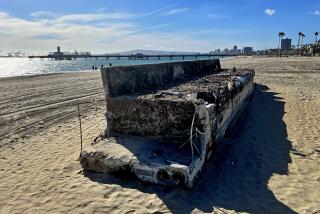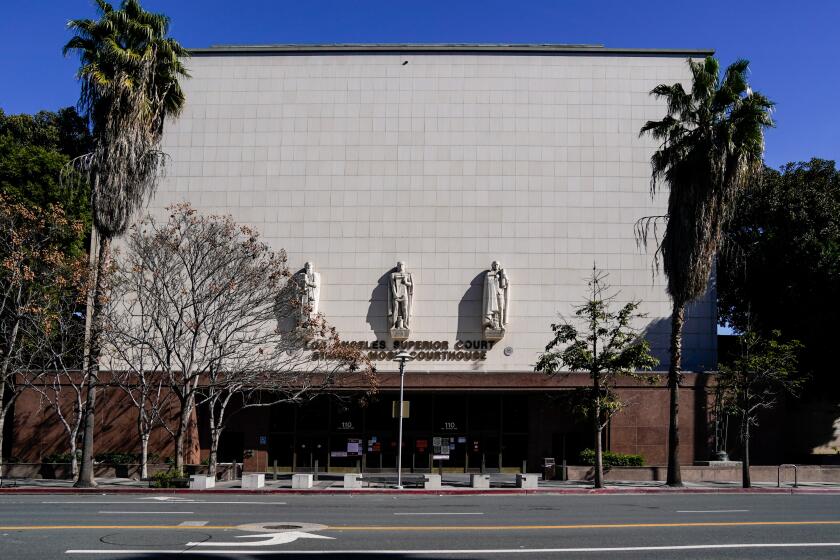What Long Beach can teach us about cycling, and politics
“This is a BFD,” exclaims Charlie Gandy on a Long Beach street corner, but it’s not what you think.
“BFD” is Gandy’s playful shorthand for a bike-friendly business district, and Gandy is giving me his tour, one he has given dozens of times, of the bike-friendly Long Beach that he helped create — starting at Bikestation Long Beach, a 24-hour bike storage, rental and repair station at the heart of downtown’s transit corridor; and including Jones Bicycles, apparently the oldest bike shop west of the Mississippi; and parklets featuring restaurant diners sipping their iced teas in the middle of the street, where cars used to park but cyclists now hitch their bikes; and a “biking boulevard” next to which a remarkable number of cycling activists live, where car traffic is slowed by European-style roundabouts and kids commute from home to school by bike.
Some of this is new. And of course plenty of it isn’t. Kids riding their bikes to school? Well, big deal. Isn’t that the suburban norm? It was where I grew up, in the Valley, in the 1970s. Although, come to think of it, I have never seen a single child pedaling to Aldama Elementary School in Highland Park, where I live now. Sure, there’s the one dad who rides there every day with his kid in the little car over his front wheel, but otherwise, I see parents either walking their kids or (mostly) lining up their cars on Avenue 50 to drop them off.
VIDEO: Do you drive in L.A.? Watch this to see what scares cyclists.
And parklets where parking used to be? Heck, we’ve got one of those a few blocks away on York.
But Long Beach is different. Sure, it’s mostly flat, which makes it easier to carry on a cycling lifestyle and cycling commuting patterns. But it’s also far more — well, more thought through. The pieces work together. Some people spent a lot of time on this, and it shows. And Long Beach is prospering because of it.
Long Beach calls itself the most bicycle-friendly city in America, and although that overstates things, the city once known as the final resting place of the Queen Mary has made its mark, surpassing Santa Monica in bike-friendly infrastructure, aiming to meet standards set by Davis and Berkeley, leaving Los Angeles in its slipstream.
VIDEO: Do you bike in L.A.? Watch this to see what concerns all those drivers.
I’m here in part because of a question a woman asked me on a Saturday morning last September. I was a last-minute substitute on a panel at the 2013 Congress of Neighborhoods at Los Angeles City Hall, and in the course of the discussion I mentioned another meeting — a contentious session in Eagle Rock earlier that summer that Councilman Jose Huizar had called to get input on a plan to restripe Colorado Boulevard. One lane of automobile traffic was to be removed in each direction, replaced by bike lanes. Opinions were aired, but it was a done deal; Huizar announced at the end of the meeting that the plan was to go forward.
Why, the woman at City Hall asked that Saturday in September, do these bike riders get everything they want when neighborhood councils have to fight just to be listened to?
I and my colleagues on the Los Angeles Times editorial board began a project — RoadshareLA — to bring some attention to the ongoing conversation about how streets in Los Angeles are divided up, and that naturally lends itself to the sometimes entertaining and sometimes irritating mutual recriminations hurled back and forth between drivers and cyclists. And we gave them their space. But it also invites other questions. Not, perhaps, why cyclists get everything they want, because of course they don’t. But why have they had so much apparent success in advancing their agenda when others haven’t? What lessons could neighborhood councils and others learn from them?
FULL COVERAGE: Sharing the road in L.A.
In picking my first guide, the choice was obvious: Stephen Box is a cycling advocate and instructor, but importantly also the director of outreach and communications — among other roles — at EmpowerLA, also known as the Department of Neighborhood Empowerment, the city agency that serves and coordinates neighborhood councils.
Box is irrepressible. He gave me a tour of his own, but it was so chockfull of fascinating observations that it didn’t go much farther than the block across the street from the Los Angeles Times building. He pointed out things I pass every day but don’t see. That place where the bike racks used to be at the LAPD station? Unsafe, uninviting, a waste of money. That police car parked on the sidewalk? It says something about what the cops think of themselves, the laws they enforce and the streets they patrol. Box’s answers to my questions came in the form of more questions: Why do we all have to pay for the streets but only drivers get to use them? Why do car owners without garages get to use public streets to store their cars? For free?
There were other guides and other tours, on Colorado Boulevard, walking (not cycling) in Boyle Heights during CicLAvia and up Central Avenue during a ride. And before the California by Bike summit in Oakland, I got in touch with Melissa Balmer, who introduced me to her project to meld personal stories, fashion, photography. She offered, in her gentle way, to get me on a bike for the first time in 30 years. But no way.
Yeah, cyclists, I’m one of those. Deal with it.
At the summit, I heard stories I did not expect. One cycling advocate shared the story of his evolution from Central American peace activist to bike activist. Really? Yes, really — and he laid out a case for how cycling could change the world, and how he discovered that he “could be a bike activist and the world peace thing could be a side effect.” Jenna Burton of Red, Bike and Green explained the role of the bike in community health, in combating gentrification, in paying homage to black revolutionaries. A bike activist from Washington talked about learning from blind spots and missteps in the women’s movement. One leader talked about building a relationship with “the enemy” — meaning the American Automobile Assn. — but was ever-so-gently chided by another speaker who pointed out that the Triple-A was in the house and on board; in fact, was a co-sponsor of the “3-foot rule,” a new law intended to protect cyclists from passing motorists.
So by the time Balmer sat me down with Gandy in Oakland, a few things were becoming clear: These bike people didn’t just come up with some good ideas, call up some lawmakers and watch things fall into their laps. They are political organizers. They are political theorists. They are political strategists. They are political. And while their movement may have some appeal to folks on the right side of the political spectrum, they are, despite their protests that they’re all-encompassing, decidedly tilted to the left.
“If not for Rick Perry and Karl Rove,” Gandy told me at the summit, “I would be governor of Texas today.” He was smiling, but I’m pretty sure he meant it. The details were a story for another day.
He spoke instead of how he spent some time looking for his “tribe” — people with a spirit of innovation, people who preferred thinking to blind allegiance to the status quo. He read his Saul Alinsky and put those organizing practices to work to change lives, lifestyles and living patterns with the bicycle. He became a student of the National Rifle Assn.’s organizing tactics. There was a summit at legendary trial lawyer Gerry Spence’s Thunderhead Ranch, out of which came the Thunderhead Alliance, which became the Alliance for Biking and Walking.
Gandy became a pedestrian advocate and then a cycling advocate, made a good living as a consultant and eventually was brought to Long Beach, where real estate heir and broker Mark Bixby, founder of the Long Beach Bike Festival, was trying to remake the city built on land his family once owned.
Bixby died in a plane crash, but the bike consciousness he started in Long Beach kept going, with Gandy doing much of the organizing, thinking and planning.
Long Beach, he said, is a bandwagon city in his three-tiered structure: bellwether cities, like Davis and Portland, Ore., which invent new ideas and living patterns; bandwagons, with the creativity and clout to borrow good ideas and build on them; and backwater cities. As he spoke, I wondered about the Los Angeles where I have lived my whole life. We’re no bellwether. We’re no backwater either — are we?
But we’re no Long Beach when it comes to cycling, transportation, livable streets. Not yet, anyway.
Together with the theorizing and activism, do bandwagon cities need the wealth and civic clout of a Mark Bixby? Perhaps. The marketing savvy and knack for narrative of a Melissa Balmer can’t hurt either. And a developed political consciousness. Add a constituency adept at using social media to organize as well as to communicate, and together those things generally mean people in that age group that lies somewhere between high school graduation and driving (or biking?) the kids to kindergarten.
So now, several months later, as The Times’ editorial board’s RoadshareLA project concludes and as we try to learn the lessons not just of bike lanes and parking spaces but of organizing and generally getting things done, Gandy and Balmer are pointing out to me the attributes of a city that is drawing a young, creative, professional class of people who want to live a car-free lifestyle. And yes, fine, they got me on a bike, and we’re riding on streets remade to allow us and thousands of other cyclists to ride safely next to cars.
Long Beach is onto something, and although my Highland Park neighborhood has learned some of the same lessons, it seems to be learning them slower, and perhaps not as well. Long Beach may be a bandwagon, but by comparison to L.A. it’s a bellwether. And that’s a BFD.
ALSO:
Can car-happy L.A. learn to share the road?
When it comes to bike paths, L.A. should look to Orange County
New York has bike sharing. So does Chicago. So why doesn’t L.A.?
This post is part of an ongoing conversation to explore how the city’s cyclists, drivers and pedestrians share and compete for road space, and to consider policy choices that keep people safe and traffic flowing. For more: latimes.com/roadshare and #roadshareLA.
More to Read
A cure for the common opinion
Get thought-provoking perspectives with our weekly newsletter.
You may occasionally receive promotional content from the Los Angeles Times.







